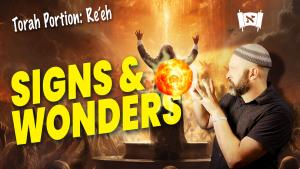Parashat Terumah - Exodus 25:1-27:19
Series:

The Forest Hidden Behind the Trees
Parashat Terumah opens with God giving Moses instructions for the building of the Mishkan, the Holy Tabernacle. When reading through this section of the Torah, and the portions that follow, it’s easy to get overwhelmed with all of the details given that describe how the Tabernacle was to be constructed. We read about planks of acacia wood, gold, silver, bronze, multi-colored yarn, linen, goats’ hair, rams’ skins, and more. We read about how each individual item had to be so many cubits wide, or so many handbreadths thick. There are so many details that many people are tempted to skip ahead and try to find where the storyline picks back up.
But we need to remember the significance of what we are reading. These instructions served as the blueprints for Moses and the Children of Israel to actually build this incredible structure called the Tabernacle. They needed to have detailed instructions so that the pieces would come together to create something spectacular. However, there is a particular detail at the beginning of these instructions that is easy to overlook. When God tells Moses that He wants the Children of Israel to build a dwelling place for Him, He says something unusual. Exodus 25:8 begins by saying, “And let them make me a sanctuary, that I may dwell in …” We would expect the final word to be “it.” God wants the Children of Israel to build Him a house that He can dwell in, right? But that’s not how it ends. The last Hebrew word of that sentence is betocham, which means “in them” or “among them.” Therefore, the passage reads:
And let them make me a sanctuary, that I may dwell in their midst. (Exodus 25:8)
In other words, the physical structure of the Tabernacle was not an end-all to itself. It was to facilitate a relationship between God and His people. God didn’t need a house to live in. He needed a place for His presence to permeate this world through His people. This temporary structure was eventually made into a permanent one. Through the guidance of King David and the direct supervision of his son, Solomon, the Tabernacle was replaced with a magnificent structure we call the Holy Temple. But even then, King Solomon knew that God could not be contained in a structure made by man. In his dedication prayer for the inauguration of the Temple, he said:
But will God indeed dwell on the earth? Behold, heaven and the highest heaven cannot contain you; how much less this house that I have built! (1 Kings 8:27)
Although the LORD's presence cannot ever be contained in a physical structure we learn from both our sages and the Apostle Paul that we can build a sanctuary for His presence on other levels other than the physical. Paul tells us one of these ways by connecting these two ideas in his letter to the Corinthians. He reminds them that they collectively represent an expression of the Holy Temple:
Do you not know that you are God's temple and that God's Spirit dwells in you? If anyone destroys God's temple, God will destroy him. For God's temple is holy, and you are that temple. (1 Corinthians 3:16–17)
No, they had not replaced the Holy Temple built by Solomon, the one that God’s presence filled upon its dedication. Paul is merely using metaphoric language to convey his point. But they had displayed the indwelling of the Spirit of God in an undeniable way, and therefore they could be seen as a sanctuary for His presence. When Paul says, “you are God's temple,” it is in the plural. He is saying that corporately they embody the Holy Temple, because they represent the initial intent of God’s sanctuary on earth. It is the same for us. By ourselves we are like the individual materials used to build the original sanctuary. Only when they were joined together did they become the Holy House of God.
Sometimes we get so focused on our own personal relationship with God that we lose sight of the larger picture of our faith. We forget that individually we are not the whole. It is only when we come together as the Body of Messiah that we become the Holy House in which His presence dwells.
I am not God’s sanctuary. You are not God’s sanctuary. He wants to build a sanctuary within us, together. Yes, God reveals Himself to the world through individuals, but it’s only through a people that He can do His greatest work. When we come together and are unified as the people of God the world will be able to see the forest hidden behind the trees. Only then will they see the abode of God’s sanctuary dwelling on earth.








